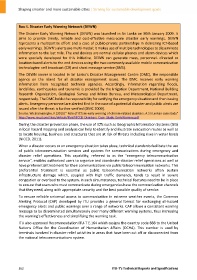Page 572 - Shaping smarter and more sustainable cities - Striving for sustainable development goals
P. 572
Box 4. Disaster Early Warning Network (DEWN)
The Disaster Early Warning Network (DEWN) was launched in Sri Lanka on 30th January 2009. It
aims to provide timely, reliable and cost‐effective mass‐scale disaster early warnings. DEWN
represents a multipartite effort and a case of public‐private partnerships in delivering ICT‐based
early warnings. DEWN's alerts are multi‐modal; It makes use of multiple technologies to disseminate
information to the last mile. The end devices are normal cellular phones and alarm devices which
were specially developed for this initiative. DEWN can generate mass, personnel‐ directed or
location‐based alerts to the end devices using the two commonly‐available mobile communication
technologies: cell broadcast (CB) and short message service (SMS).
The DEWN server is located in Sri Lanka's Disaster Management Centre (DMC), the responsible
agency on the island for all disaster management issues. The DMC receives early warning
information from recognized technical agencies. Accordingly, information regarding floods,
landslides, earthquakes and tsunamis is provided by the Irrigation Department, National Building
Research Organization, Geological Survey and Mines Bureau, and Meteorological Department,
respectively. The DMC holds the responsibility for verifying the emergency situation and then issuing
alerts. Emergency personnel are alerted first in the case of a potential disaster and public alerts are
issued after the threat is further verified (DMC 2009).
Source: Wickramasinghe, K (2011) " Role of ICTs in early warning of climate‐related disasters: A Sri Lankan case study"
http://www.niccd.org/sites/default/files/NICCD_Disasters_Case_Study_EarlyWarning.pdf
During the disaster prevention phase, the use of ICTs such as Geographic Information Systems (GIS)
in local hazard mapping and analysis can help to identify and illustrate evacuation routes as well as
to locate housing, business and structures that are at risk of threats including rises in water levels
(NICCD, 2011).
When a disaster occurs or an emergency situation takes place, technical standards facilitate the use
of public telecommunication services and systems for communications during emergency and
disaster relief operations. This capability, referred to as the "emergency telecommunication
service", enables authorized users to organize and coordinate disaster relief operations as well as
have preferential treatment for their communications via public telecommunication networks. This
preferential treatment is essential as public telecommunication networks often sustain
infrastructure damage which, coupled with high traffic demands, tends to result in severe
congestion or overload to the system. In such circumstances, technical features need to be in place
to ensure that users who must communicate during emergencies have the communication channels
that they need, along with appropriate security and the best possible quality of service.
To ensure reliable universal access to communication in extreme weather events, the Common
Alerting Protocol (CAP) developed by ITU provides a general format for exchanging all‐hazard
emergency alerts and public warnings over a range of networks. CAP allows a consistent warning
message to be disseminated simultaneously over many different warning systems, thus increasing
the warning's effectiveness and simplifying the warning task.
ITU also approved Recommendation ITU‐T E.164 which assigns the country code 888 to the United
Nations Office for the Coordination of Humanitarian Affairs (OCHA). This number is used by
terminals involved in disaster relief activities in areas that have been cut off or disconnected from
the national telecommunications system.
562 ITU‐T's Technical Reports and Specifications

